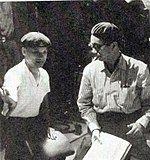Kazuo Miyagawa
Kazuo Miyagawa was born in Kyoto, Kyōto Prefecture, Japan on February 25th, 1908 and is the Japanese Cinematographer. At the age of 91, Kazuo Miyagawa biography, profession, age, height, weight, eye color, hair color, build, measurements, education, career, dating/affair, family, news updates, and networth are available.
At 91 years old, Kazuo Miyagawa physical status not available right now. We will update Kazuo Miyagawa's height, weight, eye color, hair color, build, and measurements.
Born in Kyoto, Miyagawa was taken with sumi-e Chinese ink painting from the age of eleven and began to sell his work as an illustrator while a teenager. He became interested in the cinema during the 1920s, particularly admiring the German Expressionist silents. He joined the Nikkatsu film company in 1926 after graduating from Kyoto Commercial School. He began as a laboratory technician before becoming an assistant cameraman.
Miyagawa is best known for his tracking shots, particularly those in Rashomon (1950), the first of his three collaborations with filmmaker Akira Kurosawa. The other films with Kurosawa were Yojimbo (1961) and Kagemusha (1980). He also worked on multiple films directed by Kenji Mizoguchi, including Ugetsu (1953), but only on a single Yasujirō Ozu production, Floating Weeds (1959). He oversaw 164 cameramen for Kon Ichikawa's Tokyo Olympiad (1965), a documentary which necessitated the development of new exposure meters and viewfinders. Earlier, he had worked with Ichikawa on the drama films, Enjō ("The Temple of the Golden Pavilion", 1958), Odd Obsession (aka, The Key, 1959) and The Broken Commandment (1962).
Miyagawa worked with Masahiro Shinoda in the 1980s, and at the end of his life was supervising the director's Owls' Castle ("Fukuro no Shiro"/"Castle of Owls", 1999).
Miyagawa is considered the inventor of the cinematographic technique known as bleach bypass, for Ichikawa's film Her Brother (1960).
